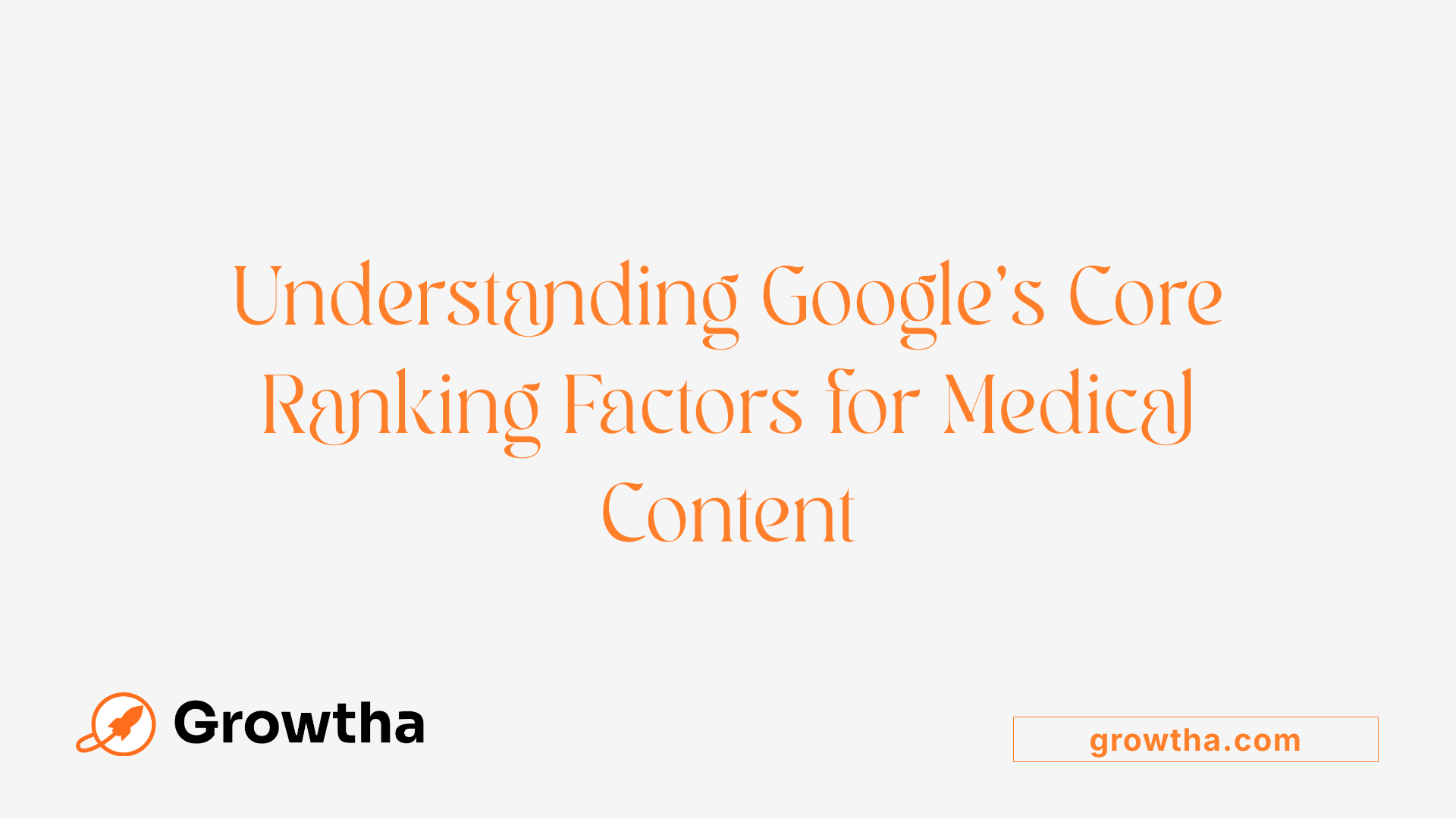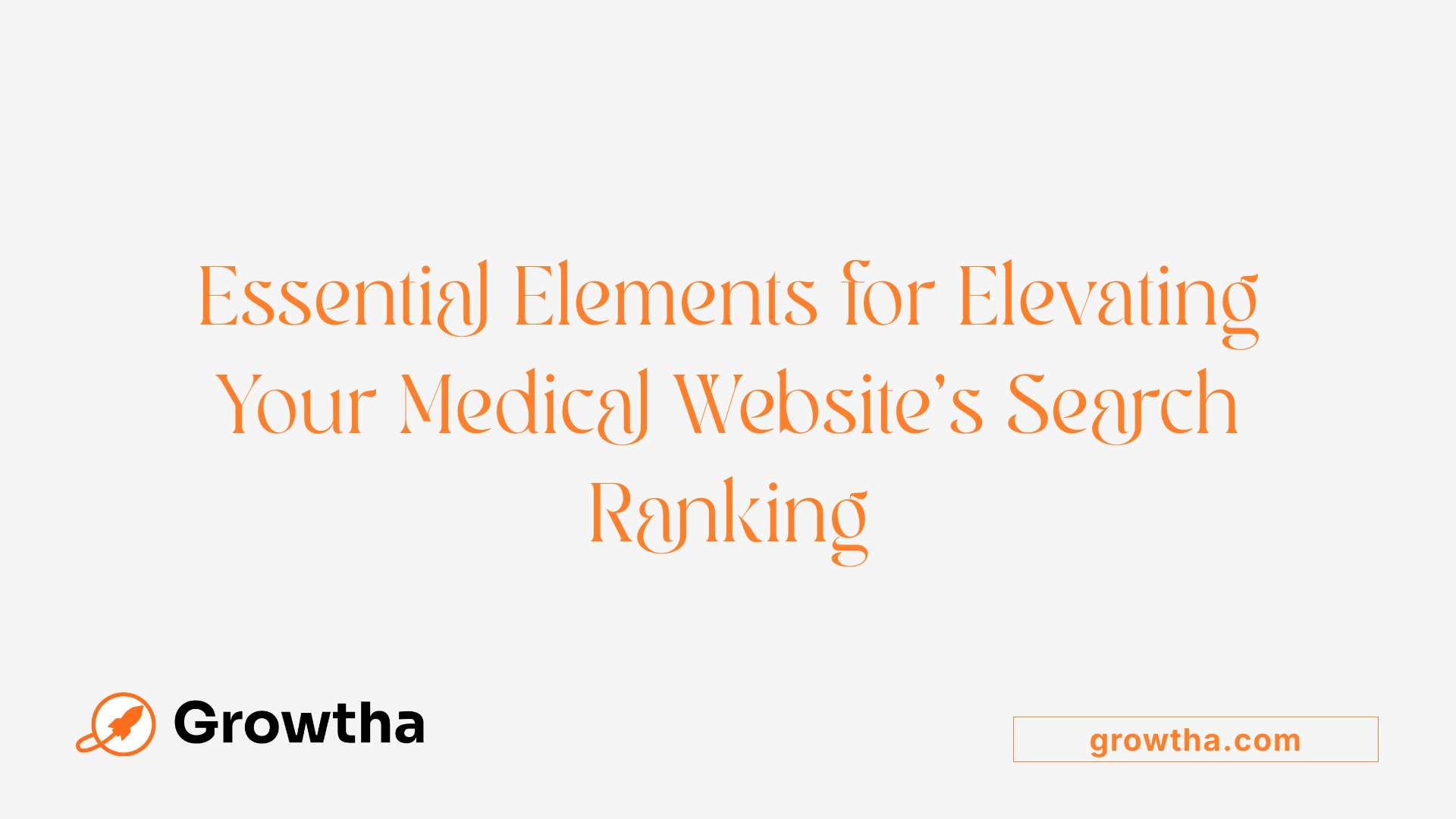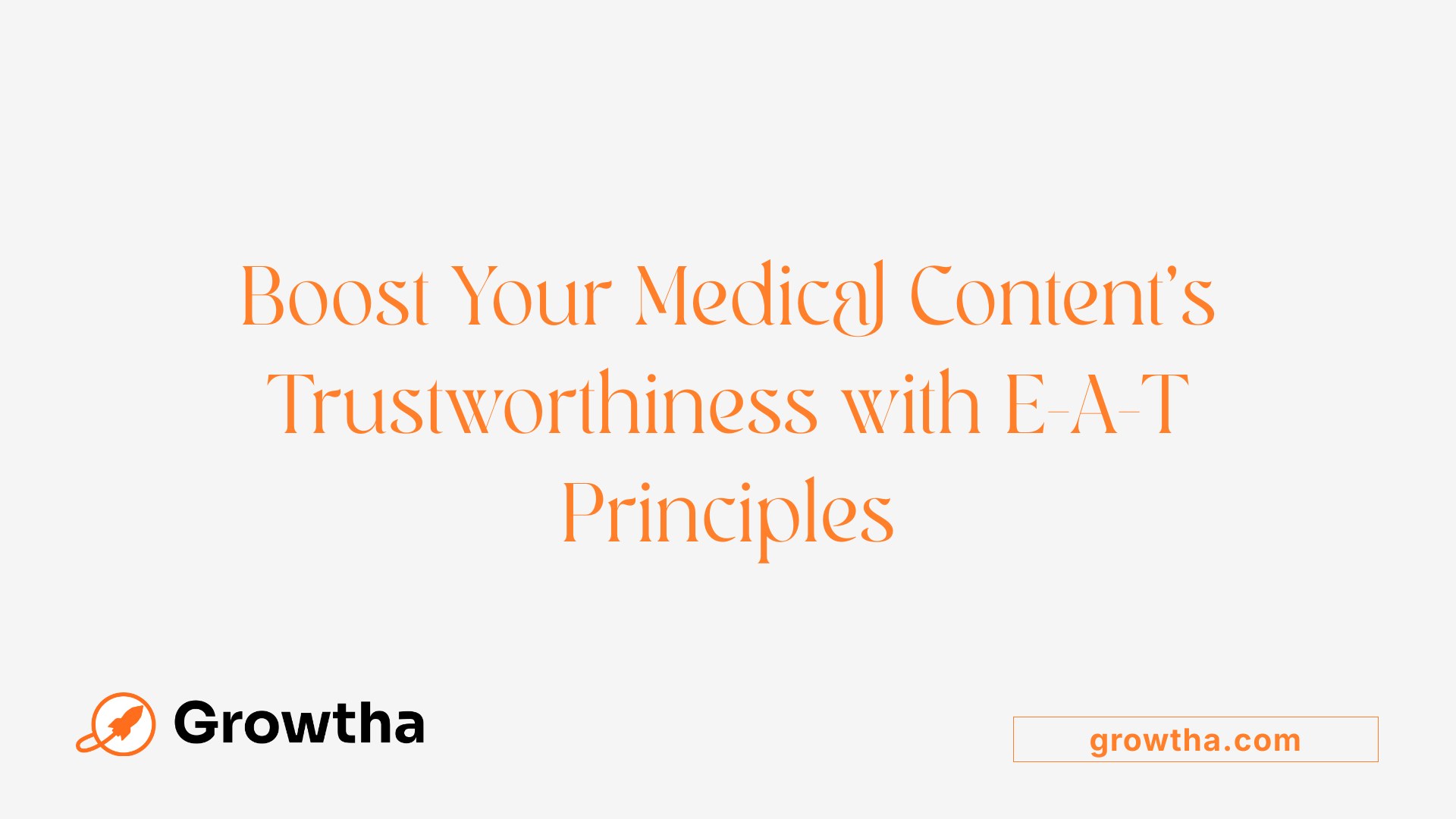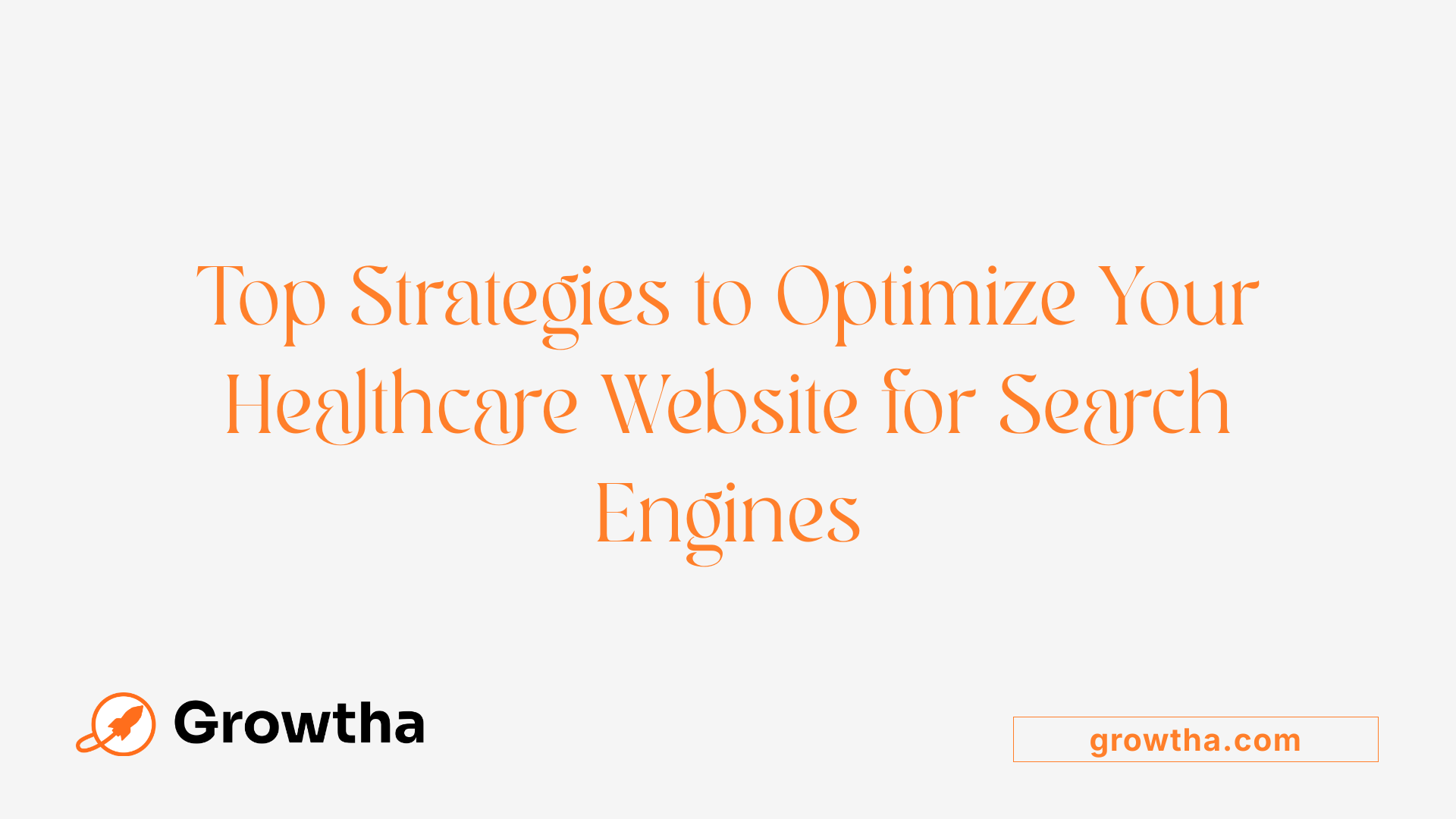How Google Ranks Medical Websites
Understanding the Complex Process Behind Google’s Medical Website Rankings


How Google Ranks Medical Websites
Introduction to Google’s Ranking System for Healthcare Content
Google's search algorithm is a sophisticated system that ranks medical websites based on multiple factors aimed at delivering the most relevant, trustworthy, and high-quality health information to users. Given the importance of accurate health-related data, Google employs various signals and updates to evaluate and rank healthcare content effectively. This article explores how Google determines rankings for medical websites, the key factors involved, the impact of its E-A-T guidelines, and best practices for healthcare providers to enhance their search visibility.
The Core Components of Google's Ranking Algorithm for Medical Content

How does Google determine website rankings?
Google's approach to ranking websites, especially in the medical and health niche, involves an intricate system that assesses over 200 different factors. These factors combine technical specifications, content quality, relevance, and authority to deliver the most useful results for users.
At the heart of Google's ranking system are core algorithms and AI systems like PageRank, RankBrain, and BERT. PageRank analyzes backlinks from reputable sources to gauge a site's authority, with higher quality backlinks signaling credibility. RankBrain, an AI system, helps Google understand the intent and context behind search queries, improving relevance especially for complex or conversational searches. BERT (Bidirectional Encoder Representations from Transformers) advances this understanding by interpreting the nuances of language, such as synonyms and related terms, which is critical for health-related searches where clarity and accuracy are paramount.
Content relevance and quality are major determinants. Google prioritizes original, well-researched, and up-to-date health information, often authored by recognized experts. It uses signals like keyword relevance, placement in titles, headers, and meta descriptions, as well as the overall comprehensiveness of the content. Google’s E-A-T (Expertise, Authority, Trustworthiness) standards specifically emphasize content created by qualified medical professionals, especially for YMYL (Your Money or Your Life) pages that impact health or safety.
Backlinks from reputable authority sites play a crucial role in establishing a website's trustworthiness. For healthcare websites, backlinks from recognized medical institutions, professional organizations, or peer-reviewed publications boost rankings significantly. Equally important is a site’s overall authority, which is built through consistent publishing of accurate, high-quality content and active engagement in the medical community.
On the technical side, page speed, mobile responsiveness, and security are fundamental. Google favors websites that load quickly, are easy to navigate on mobile devices, and employ HTTPS encryption to ensure data protection. These technical factors enhance user experience and are factors in ranking algorithms.
To summarize, Google's ranking algorithm for health content is designed to prioritize accessible, authoritative, and trustworthy information. This involves a blend of advanced AI systems evaluating language and intent, alongside technical website performance metrics. A strong backlink profile and adherence to technical best practices elevate a health website’s chances of appearing higher in search results, making these elements essential for healthcare providers aiming for better visibility.
| Aspect | Key Focus | Additional Details |
|---|---|---|
| PageRank | Backlink authority | Links from reputable sites enhance credibility |
| RankBrain | Search intent understanding | Helps interpret complex health queries |
| BERT | Language comprehension | Distinguishes nuanced patient queries for accurate results |
| Content Relevance | Keyword placement, freshness, and expertise | Original, detailed, and current information preferred |
| Site Authority | Overall reputation in health niche | Recognized credentials, professional involvement, authoritative backlinks |
| Technical Performance | Speed, mobile-friendliness, security | Regular optimizations improve user experience and rankings |
Keeping these core components in check and continuously optimizing your health website according to Google's evolving standards is essential for achieving and maintaining a high search ranking. This comprehensive focus not only enhances visibility but also builds trust with your audience, ultimately supporting better health outcomes and reputation management.
Key Factors Influencing the Ranking of Medical Websites

What are the key factors affecting the ranking of medical websites?
The positioning of medical websites in search engine results hinges on multiple essential components. Foremost among these is the quality of content. Search engines like Google prioritize pages that provide accurate, relevant, and well-researched health information. This is especially critical in healthcare, where misinformation can have serious consequences. Ensuring content is written or reviewed by qualified healthcare professionals enhances its credibility and helps establish Google’s E-A-T (Experience, Expertise, Authority, Trustworthiness) standards.
Technical SEO practices also significantly influence rankings. Fast page load speeds, mobile responsiveness, and security features like HTTPS encryption are non-negotiable for user experience and search rankings. Proper site architecture, including clear navigation and optimized URLs, makes it easier for search engines to crawl and index your website efficiently. Additionally, implementing structured data markup, such as schema for medical services, helps search engines understand and display your content effectively.
Local SEO strategies are vital for healthcare providers with physical practices. This includes optimizing your Google Business Profile with accurate, up-to-date information, managing reviews, and embedding location-specific keywords in your site content. Building authoritative backlinks from reputable healthcare organizations and directories further boosts your site’s credibility and authority.
User experience factors such as ease of navigation, accessibility for people with disabilities, and engaging calls-to-action increase user engagement and encourage visitors to stay longer. Regular content updates like blogs, FAQs, and news articles keep your website current, signaling activity and relevance to Google.
Combining these elements creates a comprehensive SEO framework that enhances visibility, fosters trust among patients, and improves overall search engine ranking. Maintaining adherence to healthcare regulations and continuously optimizing based on search engine algorithms and user behavior ensures sustained success.
| Factors | Description | Impact on SEO |
|---|---|---|
| Content quality, relevance, and accuracy | Well-researched, professional health information authored by qualified professionals. | High |
| Expertise, Authority, Trustworthiness (E-A-T) | Demonstrating medical expertise, authoritative presence, and trustworthy information. | Crucial |
| Technical SEO practices | Fast loading, secure, mobile-friendly websites with structured data and good site architecture. | Essential |
| Local SEO strategies and reputation management | Optimization of Google My Business, local keywords, reviews, backlinks from local sources. | Vital |
| User experience | Easy navigation, accessibility, engaging calls-to-action, and quality media. | Significantly impacts rankings |
Understanding and integrating these critical aspects empower healthcare websites to achieve higher visibility and trustworthiness, ultimately attracting more patients and building a reputable online presence.
The Impact of Google's E-A-T Guidelines on Medical Content

What is Google's E-A-T guideline and how does it impact medical website rankings?
Google's E-A-T framework, which stands for Experience, Expertise, Authority, and Trustworthiness, is a set of criteria used to assess the quality of online content. This has significant implications for health-related websites, a category often classified as YMYL (Your Money or Your Life), where inaccurate information can lead to serious consequences.
In the context of healthcare content, E-A-T emphasizes the importance of content created or reviewed by qualified medical professionals with genuine experience. It also stresses the need for credible sources and transparent author credentials. This combination signals to Google that the information is reliable and authoritative.
High E-A-T signals are reinforced through several practices, including the publication of accurate, evidence-based information, earning backlinks from reputable health sites, implementing proper schema markup for better indexing, and maintaining a positive online reputation.
Google’s Search Quality Evaluator Guidelines are tools used by human raters to assess these factors manually, which in turn influences the algorithm that ranks web pages. When a healthcare website demonstrates high E-A-T, it is more likely to rank higher in search results, increasing visibility and user trust.
Why is E-A-T especially vital for YMYL content?
YMYL pages impact a user’s financial stability, health, safety, or well-being. Because of this, Google places greater importance on the quality and trustworthiness of medical content. It aims to ensure users receive advice and information that are safe, accurate, and sourced from qualified professionals.
Failure to meet E-A-T standards can result in lower rankings or even penalties, which could jeopardize a healthcare provider’s online reputation. Conversely, content that scores well on E-A-T can help establish the site’s authority, improve search engine ranking, and build patient trust.
The role of author credentials, credible sources, and schema markup
Author credentials are critical indicators of expertise in healthcare websites. Displaying clear qualifications, professional titles, and affiliations enhances perceived authority.
Using reputable sources—such as peer-reviewed studies, official health organizations, and trusted medical journals—also strengthens E-A-T signals. Properly citing and linking to these sources not only adds credibility but also demonstrates transparency.
Schema markup, a type of structured data, helps search engines understand the content better. Implementing schema for medical entities, reviews, and professional qualifications can boost a website’s visibility and trust signals.
How reputation, backlinks, and online reviews influence E-A-T
A website’s reputation is built on its perceived reliability over time. Positive online reviews, especially from verified patients, can significantly improve trustworthiness. These reviews influence both user decision-making and Google's perception of the site.
Backlinks from reputable health organizations, medical journals, and authoritative sources are one of the strongest signals of authority. They demonstrate that the website is recognized within the healthcare community.
Maintaining a clean online reputation by managing patient feedback and promptly addressing concerns further reinforces credibility. High-quality backlinks, combined with a positive reputation and reviews, form a comprehensive strategy to enhance E-A-T and overall search rankings.
| Aspect | Description | Impact on E-A-T |
|---|---|---|
| Author Credentials | Display professional qualifications and affiliations | Enhances expertise and authority |
| Credible Sources | Use peer-reviewed studies and trusted organizations | Builds trust and accuracy |
| Schema Markup | Implement structured data for medical info | Improves search appearance and trust signals |
| Reputation & Reviews | Gather positive patient reviews and manage online feedback | Bolsters trustworthiness and reputation |
| Backlinks | Obtain links from reputable health sites | Signifies authority and trustworthiness |
Focusing on these factors aligns healthcare websites with Google’s expectations of high-quality, trustworthy medical content. This approach not only improves search engine rankings but also enhances the credibility of the site in the eyes of patients seeking reliable health information.
Strategies for Optimizing Medical Websites for Search Engines

What SEO strategies can improve the visibility of medical websites in search results?
To enhance the search engine visibility of healthcare websites, implementing comprehensive SEO strategies that balance quality content with technical proficiency is crucial.
Content creation forms the foundation of effective healthcare SEO. This involves developing accurate, relevant, and engaging content that incorporates primary, secondary, and Latent Semantic Indexing (LSI) keywords naturally. Content should answer common patient questions, include key pages like About, Contact, and Testimonials, and undergo regular updates to stay current and accurate.
In addition to compelling content, technical SEO optimizations are vital. Ensure your site loads quickly, is fully mobile-responsive, and uses HTTPS to guarantee security. Structured data markup, such as schema for medical services and reviews, facilitates better indexing and rich snippets in search results. Fix broken links, establish a logical navigation hierarchy, and submit an XML sitemap to help search engines crawl the site efficiently.
Local SEO efforts are particularly significant for healthcare providers with physical locations. Claim and optimize your Google My Business listing, using location-specific keywords in titles, meta descriptions, and throughout website content. Embedding maps, managing reviews, and maintaining consistent NAP (Name, Address, Phone number) details across platforms bolster local search rankings.
Building authority through backlinks from reputable healthcare organizations, academic institutions, and industry publications enhances trust signals that Google considers in its ranking algorithm. Internal linking strategies also distribute page authority across your site.
Continuous content updates and compliance with healthcare regulations such as HIPAA are necessary to maintain credibility and protect patient information. Using analytics tools like Google Search Console and Google Analytics allows you to monitor performance and refine your SEO approach.
Overall, integrating these tactics ensures your healthcare website is optimized for search engines, improving visibility, attracting more patients, and establishing your practice’s authority.
| SEO Aspect | Strategies | Additional Details |
|---|---|---|
| Content Creation | Use keywords strategically | Incorporate primary, secondary, and LSI keywords naturally in high-quality content |
| Technical SEO | Improve site speed, mobile responsiveness, secure protocols | Use tools like Lighthouse, fix broken links, implement schema markup |
| Local SEO | Google My Business, local keywords, reviews | Embed maps, maintain NAP consistency, optimize local pages |
| Authority & Backlinks | Build reputable links | Collaborate with authoritative sites, guest posts, internal links |
| Content Updates | Regularly refresh info, comply with regulations | Keep content recent, compliant with HIPAA, add new blog posts |
Expanding your online presence through social media engagement and online reviews also supports search visibility. Follow Google's guidelines and stay updated on algorithm changes like Core and Panda updates to adapt your strategies accordingly.
Limitations and Challenges in Google’s Medical Content Ranking System
What are some limitations of Google’s algorithms in assessing the quality of medical information?
Google’s ranking systems have advanced significantly with the integration of artificial intelligence and machine learning, yet they still face several notable limitations when it comes to medical content.
Firstly, these algorithms primarily rely on signals such as authoritativeness, trustworthiness, content consistency, and backlink quality. While these are useful indicators, they do not always accurately reflect the factual correctness or scientific validity of health information. For example, a website may have many backlinks or a professional appearance but still spread outdated or incorrect medical advice. Consequently, the system can inadvertently favor less reliable sources if they manipulate these signals.
Additionally, duplicated or plagiarized content can mislead algorithmic assessments. When low-quality or commercial pages duplicate authoritative content, the system may struggle to distinguish original and trustworthy sources. This can result in reputable sites being outranked or low-quality websites gaining undue prominence, misleading users seeking accurate health information.
Second, the limitations of Google’s algorithms become apparent with nuanced medical topics or emerging scientific discoveries. While the algorithms can recognize standard medical facts, they often lack the capacity to interpret the subtlety or context required to assess the latest research correctly. New or evolving health science can be misclassified or undervalued, especially if authoritative sources have not yet established widespread online presence.
The ongoing updates to core ranking systems, such as Google's Medic update and the integration of systems like BERT and RankBrain, aim to refine the focus on content relevance and quality. However, fluctuations in search rankings continue to occur, illustrating that the evaluation process is not yet perfect.
Furthermore, algorithms may struggle to identify misinformation or pseudo-science accurately. They are trained on broad signals and may not reliably demote content that superficially appears trustworthy but is fundamentally misleading. As a result, false or harmful health claims can slip through the rankings, posing risks to users.
Overall, while Google has implemented measures like the E-A-T (Expertise, Authority, Trustworthiness) framework and updates that emphasize authoritative health content, the evaluation mechanisms are inherently imperfect. They are susceptible to manipulation, misjudging the reliability of sources, and cannot fully understand the scientific complexity of medical topics. As health information often influences critical decisions, these limitations highlight the importance of users consulting qualified healthcare professionals, rather than relying solely on search results.
In summary:
- Reliance on surface signals rather than content accuracy.
- Difficulty in detecting duplicated or copied content.
- Challenges in interpreting nuance or the latest scientific evidence.
- Potential for misleading or low-quality content to appear prominently.
These constraints underline the continuous need for improvement in algorithmic assessments and supplementary measures, such as verified medical accreditation and trusted content curation, to deliver reliable health information online.
Additional Considerations and Future Directions for Google’s Health Search
How does Google’s system adapt to new health content and emerging scientific knowledge?
Google’s search system is designed to stay current with the rapid evolution of medical science and health information. To achieve this, Google deploys advanced AI and machine learning tools such as RankBrain and BERT. These systems analyze search queries and web content to understand the context, intent, and nuanced meanings behind complex health topics.
RankBrain helps interpret ambiguous or new queries by associating them with known concepts, enabling Google to deliver relevant results even for unfamiliar or evolving medical terms. BERT (Bidirectional Encoder Representations from Transformers) enhances this understanding further by analyzing the entire query in context, rather than just individual keywords. This allows Google to distinguish between terminology, related conditions, and user intent.
Ongoing algorithm updates and improvements are crucial to keeping health information accurate and trustworthy. Google regularly tests and refines its ranking systems based on new data, user feedback, and scientific developments. It emphasizes the importance of high-quality, original content authored by medical professionals, which tends to be more reliable and aligned with current research.
Medical knowledge is constantly expanding, and Google’s systems adapt by prioritizing authoritative sources and updating ranking signals. For example, official guidelines, peer-reviewed articles, and trusted health organizations influence ranking criteria.
Furthermore, social signals—such as shares, reviews, and user engagement—play an increasingly important role in visibility. Local SEO remains critical for healthcare practices with physical locations, with Google recognizing the importance of location-specific queries.
Transparency regarding medical credentials, source citations, and author expertise is also essential. Google emphasizes trustworthy content, which includes clear attribution of medical information to qualified professionals, ensuring that search results reflect current scientific consensus and best practices.
The importance of high-quality, original content
As the backbone of a trustworthy healthcare website, high-quality, original content is vital. Google prioritizes content that provides unique insights, in-depth analysis, and directly addresses user questions. Medical professionals should produce well-researched, evidence-based material that adheres to standards like Google’s E-A-T (Expertise, Authority, Trustworthiness).
Creating original content mitigates the risks associated with duplicate or outdated information. Google’s algorithms are increasingly adept at detecting patterns indicative of copied or low-value content, which can harm rankings.
Content should be regularly reviewed and updated to reflect the latest scientific evidence. Incorporating recent research articles, clinical guidelines, and patient education materials ensures information remains accurate and relevant.
Role of social signals and local SEO
Social signals—such as sharing, comments, and online reviews—contribute indirectly to search rankings. An active social media presence can increase visibility, drive traffic, and signal relevance to Google.
Local SEO practices are particularly crucial for healthcare providers. Optimizing Google My Business listings, using location-specific keywords, and embedding maps on websites help improve local search visibility. Positive reviews and accurate NAP (Name, Address, Phone number) information establish local authority.
Google values user engagement and local relevance, especially for services where patients need nearby providers. Creating dedicated pages for different locations and maintaining consistent information helps target local inquiries effectively.
Adhering to medical regulations and transparency
Trustworthiness is not only about content quality but also about compliance with medical regulations. Healthcare providers must clearly display qualifications, medical licenses, and source citations.
Transparency enhances credibility and trustworthiness. Disclosing authorship, publishing clear privacy policies, and securing websites with HTTPS are best practices recommended by Google.
In the future, as AI-generated content becomes more prevalent, strict oversight and verification will be essential to ensure compliance with medical standards and prevent misinformation.
Future outlook
Looking ahead, Google’s health search algorithms will likely become even more sophisticated, incorporating more nuanced AI systems and real-time scientific updates. As new medical research, guidelines, and treatments emerge, search results should reflect the most current and trustworthy information.
This evolution will require healthcare content providers to maintain high standards for originality, accuracy, and transparency. Embracing these principles will ensure that their websites remain visible and reputable in an increasingly digital healthcare landscape.
By aligning with technological trends and regulatory standards, healthcare organizations can better serve patients and uphold the integrity of medical information online.
| Aspect | Current Focus | Future Trend | Notes |
|---|---|---|---|
| AI Tools | RankBrain, BERT | Advanced AI systems for better understanding | Ongoing refinement for medical context |
| Content Quality | Original, evidence-based | More emphasis on credibility and verification | Professional oversight essential |
| Local SEO | Google My Business, reviews | Hyper-local tailored content | Increases local patient engagement |
| Medical Transparency | Clear authorship, credentials | AI-assisted content verification | Protects trustworthiness |
| Algorithm Updates | Continuous testing, updates | Integration of real-time scientific data | Keeps results current |
Staying ahead in healthcare SEO requires ongoing adaptation to technological advancements and content standards. Ensuring that health information remains accurate, authoritative, and user-centered is the ultimate goal of Google’s evolving search ecosystem.
Final Considerations for Healthcare Content Optimization
Google’s ranking of medical websites is a multifaceted process driven by a blend of technical SEO, content quality, authority signals, and adherence to guidelines like E-A-T. Healthcare providers aiming for high visibility must focus on delivering accurate, comprehensive, and up-to-date information authored by qualified professionals, supported by a robust technical infrastructure, and optimized for local and mobile search. While Google's system continues to improve through AI and algorithm updates, limitations persist, especially in accurately assessing content credibility and scientific nuance. Staying current with best practices and maintaining transparency and trustworthiness remain the bedrock of successful healthcare SEO, ultimately helping ensure that users find reliable and valuable medical information.
References
- Healthcare Content Success: 10 Proven Steps to Dominate Google ...
- Ways to Rank Your Medical Websites Higher on Google
- How to optimize your healthcare content to rank higher - Blog
- How to make your medical practice website rank on Google - Tebra
- Medical SEO and Google's New Requirements : What You Should ...
- Google Ranking Factors Your Medical Practice Should Know | EHM
- How Medical Websites Can Stay abreast with Google Updates
- How to get your healthcare website to rank higher in search
- SEO for Doctors: How to Rank Your Medical Practice on Google
- Is There a Problem? Case Study: Supplements for Cancer - PMC







